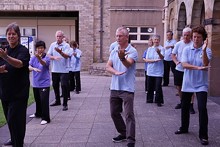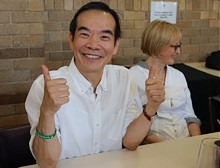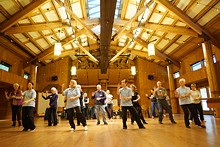The Combined 42 Forms
By: Dr Paul Lam |
© Copyrights Tai Chi Productions 2007. All rights reserved, no part of this article may be reproduced in any forms or by any means, without permission in writing, except for non-profit educational purpose. For example: you can photocopy this article for a friend, paying student, or conference participant as long as this article is not included as part of your charge |
Synopsis: This set can be suitable for almost anyone and is gaining popularity rapidly since its creation in 1990. This article outlines its background and structure, as well as a brief history of the most popular 24 Forms. The 42 Forms is the official competitions Forms in major international competitions. Go to: What is a Set of Tai Chi Forms? Tai Chi is a powerful art of immense depth; the set of Forms is the structure or the foundation. According to Yang Chan Fu (who is known by many as the modern father of Tai Chi in the 30’s) “to start learning Tai Chi you have to start with the Forms”. There are many styles of Tai Chi, and within each style, it has different Forms. Even with one well-known set of Forms, there are many versions. Students might feel confused facing so many choices, or they could take it as an advantage to have so many choices available. While one can practise just about any one good set of Forms and develops very high level Tai Chi, there are advantages learning more sets. Different sets and styles of Forms have their own unique characteristics and points of interest. Learning more sets enriches one’s techniques, broaden horizon and is a fun and challenging thing to do. To many, learning different sets helps to improve the levels of their Tai Chi faster. Since different Forms and styles have their unique characteristics and some characteristics might be more suitable to one person than another, it is beneficial to examine different Forms and styles. Many traditional Forms are excellent, some of these might not be suitable for modern time. The 42 Forms has many features and advantages compare to many others. The Advantage of Understanding the Background and Structure of a Set of Forms It is helpful and interesting to understand structure and background history of sets. Like an artist playing a musical composition, it is possible to play the music well, but to play it as a piece of art it becomes necessary to understand the inner meaning, the composer’s intention and the structure of the piece. This can be difficult for the older set of Forms since Chinese martial art history is mixed with many legends; it is not always possible to find out the true version. Fortunately for the modern Forms, we have a better chance to access good information. History of Tai Chi Tai Chi utilises techniques that could date back to more than a thousand years. However, the accountable history of Tai Chi dates back to the 16th Century in the Chen Village in Wen Xian County, Henan Province. Like most great arts which survives and improves with the passage of time, Tai Chi went through a great deal of changes. With changes of time, the needs in society changes and Tai Chi has evolved to meet the challenge of time. For example, the need for self defence is of less importance nowadays, so Tai Chi has been proven to be one of the most effective exercises for health. From Chen style comes Yang style created by Yang Luchan, from both Chen and Yang styles other styles such as Sun, Wu and Wu Style have originated. Some of these older Forms have certain challanges in modern time. For instance, the Chen style has two sets of Forms, the first set is the 83 Forms (known in Chinese as the first road) and it takes approximately 35 minutes to complete these Forms. The second set (The Cannon Fists) is much more vigorous. It was said that if you work hard at the 83 Forms full time for three years, then you are ready to learn the second set. This may be suitable if we make Tai Chi a University course. Students can study the first set full time for three years as a Bachelor degree, then make the second set a post-graduate degree. While many enthusiasts would like to see this made reality, for most of us, this is not suitable. Take another example, the classical Yang style, the 88 Forms takes approximately 30 to 40 minutes to practise, not to mention how long it will take to learn. After learning it, if you were to practise just three rounds of the set per day then you will need approximately two hours. Most of our students will find it difficult to devote 2 hours per day for practise. In order to popularise Tai Chi; the Chinese National Sports Committee had authorised the country’s four most renowned Tai Chi experts to compose The 24 Forms. Based on the Yang style, and by eliminating many repetitions and retaining the essential principles of Tai Chi, the 88 Forms was condensed to only 24 Forms. The 24 Forms is easier to learn, to remember and practice, the set takes around five minutes. A busy person can do three rounds in 20 minutes (including warm up exercises). The 24 Forms very quickly became the most popular Forms in the world. (For information of the instructional DVD of the 24 Forms, or the book Tai Chi for Beginners and the 24 Forms by Dr Lam) The Structure of the 24 FormsThe 24 Forms is divided into four sections. The first section consists of gentle stretching of the upper and lower limbs, which works as warming up for the later parts, such as the movement “Parting Wild Horse’s Mane”. The second section is more challenging with further stretching and turning of the body, such as the movement “Stroking Bird’s Tail” which expresses the ‘theme’ of this Forms (this movement contains the four basic moves of Push hands, is the most important form of the set). The third section contains the climax where the most challeging parts are executed, such as the “Heel Kicks”. The fourth section contains technically difficult moves such as the “Needle at The Sea Bottom”. Later slower movements such as “Apparent Closing Up” works as winding down exercise. The 24 Forms has incorporated the essential tai chi principles. The Origin of the First Combined Forms; the 48 Forms After the creation of The 24 Forms, there comes a growing demand for more challenging Forms for the purposes of further studies and demonstration. In 1976, the Combined 48 Forms were created by three Tai Chi experts headed by Professor Men Hui Feng. The combined Forms were created based on combining and condensing classical Forms of the four major styles, namely Chen, Yang, Wu and Sun. The idea is to take the best of all styles and to express these in a short space of time, not unlike the Reader’s Digest condensed version of classical novels. This idea proved to be very popular and effective. In the space age, we want to learn everything quickly, and to obtain the maximal benefits within minimal time. This is not meant to negate the need of time and patience to learn and practice Tai Chi. It is possible to achieve a specific goal with less time if we define our goal clearly and plan carefully. As Tai Chi became more popular, competition flourishes especially within China. When there is competition there are always rules and time limit becomes an important issue. The practical time limit is set on six minutes for most competitions in China. Competitor usually condenses their choice of Forms to six minutes, so in a competition every competitor will be performing different sets of Forms. This creates difficulties such as setting the standards especial when the competitors are very close in their skills. In the late eighties, the Chinese Sports Committee realised the need to standardise competition Forms. It had chosen the four major styles and a combined Forms. These five sets of Forms were created by different teams of experts. All sets of Forms thus created were named after their style, e.g., the Chen Style National Competition Forms is the 56 Forms, the Sun style is the Sun 73 Forms, and so on. The combined Forms are The 42 Forms. Since the creation of these Forms, they become the essential and most sought-after sets for competitions. Books and videos have been made for these Forms by the Chinese Sports Authority. The 42 Forms was created by Professors Men Hui Feng, head of the Wushu dept, Beijing Sport Institute (now Beijing Sport University) and Li De Yin from People’s University in Beijing in 1989. The immense popularity of The 42 Forms since its creation is an indication of how well it was composed. In October 1990, the 11th Asian Games were held in Beijing, China. For the first time in the history of the Asian Games, Wushu (martial arts) was included as an item for competition. The 42 Forms is the only Forms being chosen to represent Tai Chi. In fact, the creation of these sets have much further benefits than being useful in competitions. Standardised sets help to improve Tai Chi in general. Like the standardise the Chinese languages by the Qing dynasty. Without the standardisation of language, the culture and unity of China would not have developed so well. Background history of The 42 Forms The 42 Forms is a condensed version of The 48 Forms. One of the main differences is that where are three repetitions in The 48 Forms, The 42 Forms has only two. The 42 Forms contains the essential principles and important characteristics of the four major styles, retains the traditional principles of Tai Chi, is rich in content and technique, meticulous constructed and is fully compliant with competition rules. In terms of structure, it follows the general principle of The 24 Forms but with some significant variations. It starts with Form 2 Stroking Birds Tail immediately after the Form 1 Commencing Form. This movement displays technique and style to attract peoples’ (for both the practitioner and the spectator) interest and attention, yet it still provides gentle stretching of the upper and lower body. The rest of the first section also serves as a warm up but with movements that are more substantial than those of the 24 Forms. The second section starts with the Sun style’s Form 11 Opening and Closing, not only is this the most characteristic movement of the Sun style, it also signifies the importance of Qigong within the set. Near the end of this section, the first climax appears with the Form 17 Cover with Hand and Punch with Fistand Forms 18 Parting Wild Horse’s Mane from the more vigorous Chen style. Since there are more contents in The 42 Forms, two climaxes are needed. Section 3 starts with Form 19 Waving Hands Like Clouds a slower and easier movement to break up the intensity, then to more difficult movements to prepare for the next. The second climax starts with the fourth section by the movements such as Form 32 Body Thrust with half Horse Stance, Form 33 Turn Body with Full Roll-Back and Forms 34 Hold and Punch in Crossed Squatting Stance. Then logically the winding down comes in to finished off with another Form 40 Stroking Bird’s Tail on the other side. Throughout the Forms the balance of the body is well maintained by giving roughly equal numbers of movements for both sides (many of the traditional Forms only has the right-side movements). Each movement is carefully composed to provide suitable exercise for all parts of the body, to improve mental relaxation and mental concentration, to acquire a wide range of Tai Chi techniques and to improve the function of all internal organs. While the 42 Forms is the combination of four major styles, each stype is not represented in equal proportion, the majority of the Forms are Yang style. Being the most popular style, which is characterised by gentle and graceful movements, it is appropriate for Yang’s to be the main building blocks of the set. Form 11 Opening and Closing of Hands, Forms 12 Single Whip, Forms 14 Turn Body and Push Palm are Sun style. They are characterised by flowing movement like water in a stream, much Qigong (Chi Gong) practise such as Form 11, and whenever one foot stepping forward or backward the other foot follows. Practitioner of Yang style will notice the significant difference of Form 12 in Sun and the Yang styles. Form 17 Cover with Hand and Punch with Fist, Form 18 Parting Wild Horse’s Mane and Form 32 Body Thrust with Half Horse Stance are Chen Style. Chen’s is characterised by being more vigorous, containing attacking movements and more obvious in self defence application. Punching movements are abundant in Chen style and Form 17 is a typical example of them. Forms 20 Step Back to Subdue Tiger, Forms 21 Kicking with Toes Forward, Form 34 Hold and Punch in Crossed Squatting Stance and Forms 35 Thread Palm and Lowering Movements are Wu style, which is characterised by close to body movements and lively steps. The Pros of The 42 Forms It is amazing to have a set of Forms which embraces four major styles yet have its own life and spirit. It is rich in contents and techniques yet suitable for almost anyone to learn. It also did well to:
To do all these within six minutes are a real achievement. The Cons of The 42 Forms It is very hard to think of any negative point for The 42 Forms, perhaps the beginners might find it easier to learn The 24 Forms first before starting on the 42 Forms, as it is more challenging. While the competition time limit is 6 minutes, which does not allow a fuller expression of slowness with inner force, for normal practise it is recommended to do the Forms from 6 to 10 minutes. Summary The 42 Forms is well created with a great deal of thought and work. It contains a rich mixture of styles and techniques, yet breathes its own life as a wonderfully integrated set of Forms. It is designed to be suitable from the novice to the most advanced practitioners, fulfilling the modern needs, offering maximal benefits and techniques in a minimal time. Being beautiful to watch and practise, The 42 Forms has certainly proven to be very popular with many Tai Chi enthusiasts. Related articles |












